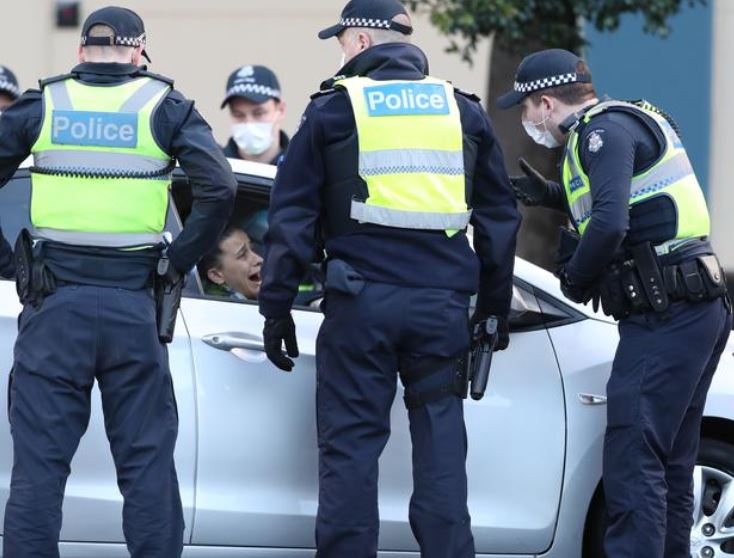Victoria Police are off to Court to battle the current industrial dispute with the Police Association.
This dispute involving pay and conditions has dragged on for far too long, which points to intransigence on the side of both parties.
The unfortunate part of this dispute is that the real victims will be the public.
There is no doubt that given the public discourse on crime at the moment, either the administration of Victoria police has got their priorities very wrong, or the police members themselves are not performing at their optimum effectiveness.
It has been reported that the force is substantially understrength, creating disquiet among the rank and file, which is totally understandable. This problem didn’t happen overnight; it has been festering for a long time and has now manifested into a major issue.
Poor recruiting practices and creating a top-heavy organisation are all the failings of the force administration.
If the Force has been trying to address the issue, there is no evidence that they are succeeding in recruiting or retention, the other key driver affecting police numbers.
Ironically, it was not that long ago that the Force dispensed with two senior ranks, Chief Inspector and Chief Superintendent, based on efficiency.
What this did was cause a fractured hierarchal structure where senior people were promoted, not having served at the various levels of command, to hone and develop their leadership skills, as was the historical case, leading to ordinary commanders at the highest levels.
The plethora of commanders at the top end of the organisation has caused the organisation to slow to a snail’s pace as each commander seeks to eke out responsibility and or relevance, stagnating creative management and the development and function of the organisation.
Moreover, the growth in the number of senior people has literally exploded contrary to the intended outcome of removing ranks.
The impact apart from the poor organisational performance is most felt at the coal face of Policing, and that translates into the reduced capacity of the organisation to perform its function, and the people suffer poor service delivery.
For every additional senior officer position, apart from that individual position being removed from the operations, their support staff will also be drawn from the frontline.
These numbers may seem small, but collectively, it is probable that ancillary staff could staff another police station.
There are any number of drivers to address retention, and among the most obvious is a lack of job satisfaction.
This industrial imbroglio will substantially negatively impact retention the longer it drags on.
Staff retention is not only impacted by bad management but also by government intervention in the police role based on ideological values rather than pragmatic outcomes.
The State would not be in the position it currently finds itself in had these issues been recognised and addressed.
On the other side of the ledger, the rank and file, represented by the Police Association, according to media reports, has shown no intention to compromise in this dispute and lacking from that side and never uttered in public discourse is that dirty word, productivity.
The public support for police, which has stood up surprisingly well, will tend to wain when they are put at risk because this dispute drags on. This is not helped by being reminded continually by police vehicles daubed in graffiti.
Public support is easily lost and very difficult to recover, making it imperative that the Chief Commissioner and the Secretary of the Police Association find a way to resolve the dispute soon.
All the Association demands are well and good; however, the Association has boxed itself into a corner where to compromise it will lose face, as the dispute drags on their position is weakened. And that, for some, will be translated into weakness rather than pragmatism to end this dispute.
The longer the resolution takes, the greater the risk there is to recovery in the relationship between the command and the frontline troops, which may become fractured beyond repair.
It is now time for the Chief Commissioner and the Secretary of the Association to meet one-on-one and thrash out a deal that can be taken to the Government.
The legal approach where the protagonist fires salvos from safely behind the lines of silk robes will more than likely exacerbate the dispute, irrespective of what the courts find.
How this dispute got to this stage is unclear. Still, we have confidence that without interference, the Chief Commissioner and the Association Secretary are well capable of thrashing out a resolution – time for leadership so direct contact with each other’s nemesis can resolve the impasse.
Get on with it.
The longer it drags on, the more damage wrought.


Hugely concerning. Most urgent issue is how long can the undermanned police last, crushed by the pressure of current lawlessness and total lack of support from the courts or a bankrupt government and with so many already off work because of the stress?
With the “explosion” in the senior ranks, and the scrapping of two intermediary Officer ranks (of which I retired as one) the result has been extremely bad for Victoria Police! It opened up the executive ranks to all and sundry who persevered at some hybrid University “attendance” course in Tasmania, without the quality control mechanism of “Airlie”, the result being total lack of respect for suss senior Officers. Additionally, the ease it is to get to high rank with the right “politics” and connections, drives unrealistic aspirations and expectations of inexperienced ambutious wanna be leaders, who fit gender and network slots. If that’s not bad enough, look at the many non core executive positions that add no value to the safety and security of Victorians. Until there is a purge of incompetent and inexperienced “Woke” driven appointments at the top levels, that suck up the salary budget, woe will be the quality of policing in this State.
Nailed it Sir, nailed it.
You’ve covered nearly all the points, however you fail to mention something that has lead to the loss of public support.
The politicisation of vicpol and the outrageous police actions during the covid madness. Many people I know who have always supported Victoria Police no longer do so. The thuggery and the use of firearms on unarmed civilians during the covid protests has left a shade over many minds, minds that have always been pro police.
The Victoria Police, really must demonstrate that what happened was wrong and that they will not act on the desires of the Gov in power, but will enforce the Law, impartially and sensibly. Until then they can count on nothing much improving in the way of public support.
In the end settlement will be determined by the power each wields. Power is largely derived from knowledge. In this case, contextual knowledge and tactical knowledge are paramount, but legal knowledge is usually part of the mix. Neither of the dueling parties shows a particular advantage in any of those areas – hence the apparent stalemate. The remaining major influence over settlement of the dispute will be wielded by the party having the capacity to lock down a deadline that is significantly punishing or rewarding [or maybe both] to the opposite party.
TPAV went to command with a log of claims substantially self serving of their own desire
A legacy and were so out of touch with rank and file they have torched them all. An alienated workforce which has been caught in the middle. Why would Xcom want to negotiate with TPAV when they’ve come back
With a proposal that is a total 180 from their original position. They knew from many months before the resounding ‘no’ from frontline to their flawed ‘deal’ and refused to reflect.
Command would NOT negotiate with Wayne GATT.
I have witnessed this directly. At St Kilda Police Station, hard-working male police officers, who have done the hard yards and have gained the vital, “local knowledge” get rotated and this experience is lost
or
DEI (Diversity Equity & Inclusion) is alive and well.
Promotions seem to be given and “earned” much faster if one “ticks a box”. Case in point, one super rude, arrogant, careless and lazy constable has received 2 promotions within 18 months as he ticks x 2 boxes: Asian and gay. Of all the new recruits over this time period specified, he is without a doubt, one of the least deserving and I have put in a written complaint about his behaviour to the relevant Inspector as well as a formal complaint to the Professional Standards Command; both of which have gone absolutely nowhere!
Hardworking officers are being “gazumped” by DEI appointments rather than promotions based on MERIT!
Also, I think that the current wage claim was very modest in comparison with that gained by other public servants who do NOT put their lives on the line.
It is shameful that the most senior Police Officer – CEO Shane Patton is at loggerheads with Head of the Police Association.
Their own “boss” should be batting for and campaigning for improved remuneration for his own members!
Unfortunately, like everything else associated with this Andrews/Allan State Government, POLITICS & PARTISANSHIP have infiltrated EVERY aspect of governing and public service – and THIS IS THE REAL DISGRACE!
Nailed it
A major issue facing Victoria Police is the fact that there is over 900 members on long term sick leave. This in turn results in large numer of Members going out on Sick Leave each day.
Well said Charlotte, hit the nail right on the head.
Front line police are on their own. I give the following observations. Leading up to the EB in November 2023, membership vote for protected action. Come November allegedly a deal is offered to the TPA by Allan govt to lift actions until May 2024. Allegedly TPA take an Executive vote and allegedly accept the Allan proposal. Membership then later backlash and not accept proposal and membership vote taken to re-commence protected actions. A loss of momentum of 1 year, why? What happened after November 2023, Tennis, Taylor Swift concerts, Grand Prix, Major Govt heads meeting and finally issue of arms displayed at “Jeffs Shed” pretty convenient. Where was TPA as attrition rate was growing into the 1000+ where was the TPA when the sick leave rate was growing to 800+ This was all on the current TPA’s watch. Last observation, two previous TPA Secretaries given government positions after their tenure with TPA.